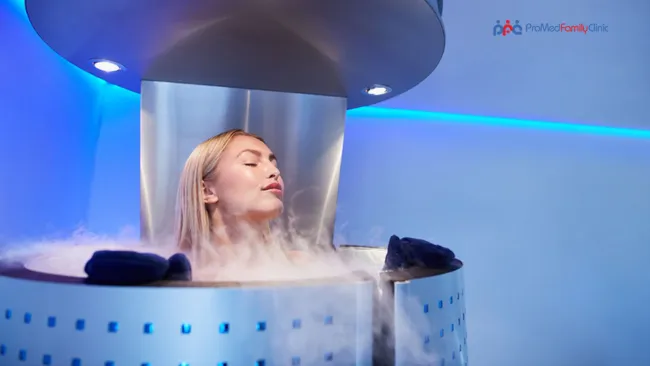Achieving Radiant Skin: Melasma Treatment and Skin Cancer Care at Prospect Skin Clinic
-
What is cryotherapy?
Cryotherapy is a therapeutic technique that involves exposing the body to extremely cold temperatures for a short period of time. The term "cryotherapy" comes from the Greek words "cryo" meaning cold and "therapy" meaning treatment. The purpose of cryotherapy is to provide various health benefits by stimulating the body's natural healing processes.
There are different methods of cryotherapy, but the most common form involves immersing the body in a specialized chamber known as a cryosauna or cryochamber. These chambers use liquid nitrogen to rapidly lower the ambient temperature, typically reaching temperatures as low as -110°C (-166°F) or even lower. The individual undergoing cryotherapy remains in the chamber for a few minutes, typically between two to four minutes.
During the session, the extreme cold triggers several physiological responses in the body. The blood vessels in the skin and extremities constrict, directing blood flow to the core in an effort to maintain body temperature. As the person exits the cryotherapy chamber, blood vessels dilate, allowing oxygenated and nutrient-rich blood to flow back to the peripheral tissues, which can promote healing and recovery.
Cryotherapy is commonly used for various purposes, including:
Pain and inflammation reduction: The cold temperatures can help alleviate muscle soreness, joint pain, and inflammation by numbing the area and reducing swelling.
Athletic recovery: Cryotherapy is popular among athletes as a method to accelerate recovery from intense training or injuries. It may help reduce muscle fatigue, enhance muscle recovery, and improve overall performance.
Skin conditions: Cryotherapy can be used to treat certain skin conditions, such as warts, skin tags, and dermatitis, by freezing the affected area and causing the targeted tissue to slough off.
Boosting metabolism and weight loss: Some proponents of cryotherapy suggest that exposure to cold temperatures can increase metabolism and calorie burning, potentially aiding in weight loss efforts.
Mental health benefits: Cold exposure may stimulate the release of endorphins and improve mood. Some individuals find cryotherapy helpful for reducing symptoms of anxiety, depression, and stress.
It's important to note that cryotherapy should be performed under the supervision of trained professionals, as extreme cold temperatures can pose risks if not properly managed. It may not be suitable for everyone, particularly individuals with certain medical conditions or sensitivities to cold. It's always advisable to consult with a healthcare provider before undergoing any new treatment.
How to care for skin after cryotherapy
After undergoing cryotherapy, it's essential to provide proper care for your skin to promote healing and minimize any potential side effects. Here are some general guidelines for skin care after cryotherapy:
Keep the area clean: Gently clean the treated skin with mild soap and water. Avoid using harsh or abrasive cleansers that can irritate the skin.
Moisturize: Apply a gentle moisturizer to the treated area to keep the skin hydrated. Look for products that are fragrance-free and suitable for sensitive skin.
Avoid hot water: Avoid hot baths, showers, or hot tubs for at least 24 hours after cryotherapy. Opt for lukewarm or cool water to prevent further irritation.
Don't scratch or pick: It's important to resist the urge to scratch or pick at any scabs or blisters that may form. Allow them to heal naturally to avoid infection and scarring.
Protect from the sun: The treated skin may be more sensitive to the sun, so it's crucial to protect it from UV rays. Use a broad-spectrum sunscreen with an SPF of 30 or higher and apply it generously before going outside. Wear protective clothing, such as hats and long sleeves, and seek shade whenever possible.
Avoid tight clothing: Choose loose-fitting clothing to prevent friction and irritation on the treated area. Tight clothing can exacerbate any discomfort or sensitivity.
Follow post-treatment instructions: Your healthcare provider or cryotherapy specialist may provide specific instructions tailored to your situation. Follow their recommendations regarding any additional care or restrictions.
Monitor for complications: Keep an eye on the treated area for any signs of infection, such as increased redness, swelling, pain, or discharge. If you notice any concerning symptoms, contact your healthcare provider.
What are three types of cryotherapy?
Whole Body Cryotherapy (WBC): This form of cryotherapy involves exposing the entire body to extremely cold temperatures, typically in a specialized chamber or cryosauna. The individual stands in the chamber for a short duration, usually between two to four minutes.
Local Cryotherapy: Local cryotherapy targets a specific area or body part rather than exposing the entire body. It involves using localized devices that apply cold temperatures to a particular region, such as an injured joint or muscle. Local cryotherapy can be administered through ice packs, cold compresses, or specialized cryotherapy devices.
Cryosurgery: Cryosurgery is a medical procedure that uses extreme cold temperatures to freeze and destroy abnormal or unwanted tissue, such as cancerous cells, warts, or precancerous skin lesions. Liquid nitrogen or a similar cryogenic substance is applied directly to the targeted area, effectively killing the unwanted cells. Cryosurgery is performed by healthcare professionals and requires specialized training.
Protect your skin, consult a Skin GP for sun safety!
You May Also Like:
Promed offer Other Services Such as;
